11th May 2017
A little downstream from the Hull Exhaust Centre, visible at left was another viewpoint, I think from a derelict wharf on the River Hull. This image, looking upstream, shows barge Torch, with number 22, owned by Hull’s Gillyott and Scott, a major tug and lighter owner formed in 1964 by amalgamation of the five companies of William Gilyott, John A. Scott, T.F. Wood, Furleys and John Deheer. Gilyott and Scott (Transport) Ltd also owned lorries. The barges are said to have been sold to Dave Hornshaw of Hornshaw Water Transport in Goole.
The buildings on the East bank are some of those on the Morley Street ultramarine works, then still part of Reckitt’s – with Hull’s tallest chimney a little out of the frame to the right. Most or all have now been demolished.
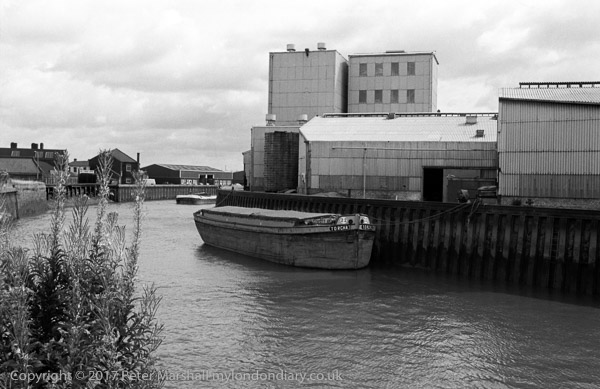
32r13: River Hull from Bankside, 1982 – River Hull
12 May 2017
The street name ‘Park View’ was helpfully painted on the side of this row of small terraced houses off Sculcoates Lane, probably because the official street name had been on a house already demolished. This row of houses was built facing the Cottingham Drain – now culverted and presumably under the grassed strip to the right. The drain was built around 1770 and drains into the River Hull close to High Flags; it was culverted in the 1960s, and several sections including this one are now cycle paths.
The houses at right are the backs of buildings on terraces off Beverley Rd. The name Park View suggests that the houses in this row are older than those – as too does the fact that these are still standing. Though I was perhaps wishful thinking and I doubt that they will ever have had much of a view of Pearson Park, hidden behind the Dorchester Hotel (around that time owned by my wife’s cousin Billy) and other large buildings on the opposite side of Beverley Rd.
Wishful thinking too in the advertising hoarding, showing a very different and tropical scene to that in front of me when I made this picture, though like Bacardi Rum, Hull too has character all of its own. And XWJ633T is an excellent example of a ‘Woodie’ Morris Minor Traveller.
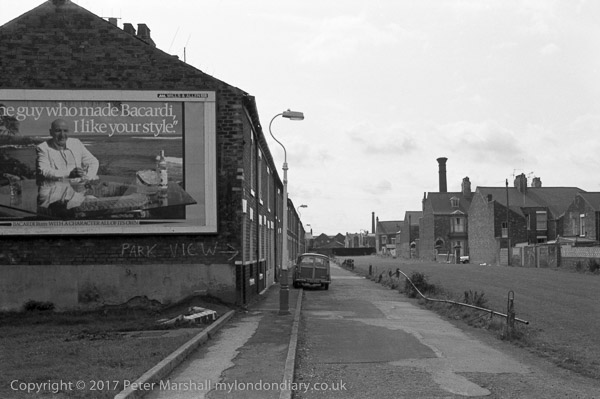
32r22: Park View and Cottingham Drain (culverted), 1982 – Beverley Rd
13th May 2017
Queen’s Terrace off Sculcoates Lane was about to be demolished, and one house was already empty and derelict, but the others were still mainly occupied. Like many other Hull streets, a series of short blind alleys – terraces – ran off at right angles to the street to enable the maximum utilisation of space, with houses on one or both sides.
Coming from the Beverley Rd, Sculcoates Lane turned sharp right immediately after crossing the Cottingham drain – culverted when I walked along it, but still noticeable as a wide grassed patch, then after a few yards the road turned back to the left (while a row of houses, Park View, continued facing the drain. A few yards along the road, first came Mary Ann’s Terrace, then Queen’s Terrace, followed by Walter’s Terrace. Finding terraces was often difficult, as for some reason the street plans didn’t include their names. There were also several Queen’s Terrace in different streets across Hull. This one was immediately to the east of ‘The Wood Shop’ at 24-28 Sculcoates Lane.
Some of the houses in the area were already demolished, and the rest seemed likely to go in the very near future. There was a small shop at the start of Queen’s Terrace, though I think it may have been 30 Sculcoates Lane, despite the street name on it, then a few houses. The shop, described in earlier directories as a beer shop, was an off-licence, and while licensed to sell beers, wines and spirits also sold ice cream, sweets etc, and I think I may have occasionally called in for a Mars Bar or a can of 7 Up on my walks.
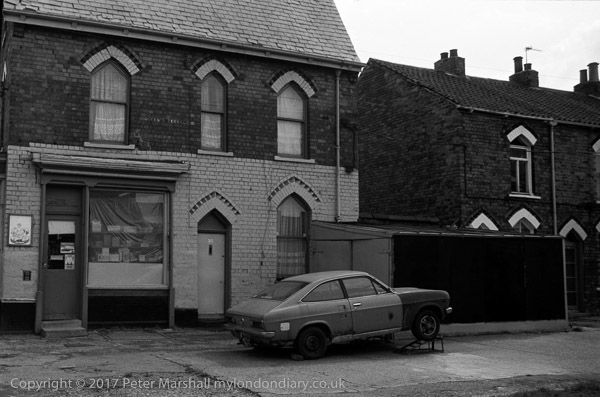
32r23: Shop on corner of Queen’s Terrace, Sculcoates Lane, 1982 – Beverley Rd
14th May 2017
A woman walks down Queens’s Terrace, off Sculcoates Lane. The 1948/9 Six Inch OS map shows a gap in the houses along the street here, as well as many other properties around also missing compared to pre-war maps, suggesting considerable bomb damage in the area. Kids growing up after the war in Hull had plenty of such informal playgrounds, often like this one with a wicket painted on the wall. I didn’t ask the woman, who I think had walked out of the open door at left, if she was ‘Angie’, the name also on the wall. The run of buildings on the right had side of the street appear to have been demolished some time after the war.
Although most Hull terraces are ‘blind’, often with just a brick wall separating them from a terrace off the next street, Queens Terrace always had an alley or tenfoot through into Tunis St (and on further to Exchange St.) The two houses at the right in Tunis St are I think still there, though somewhat altered, with the small bathroom windows replaced by ventilators.
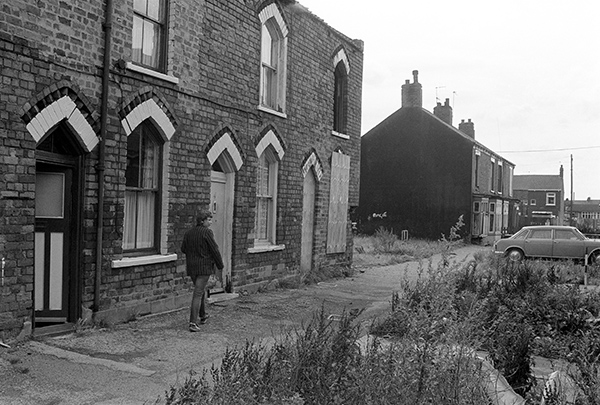
32r24: Queen’s Terrace and Tunis St, Sculcoates Lane, 1982 – Beverley Rd
15 May 2017
The River Hull is out of sight between these two large objects that it amused me to join together in the picture. Reckitts had originally relied on imported ultramarine to use in their ‘Reckitt’s Blue’ washing additive, but began to make their own when it became difficult to get supplies because of the Austro-Prussian wars in the 1860s. In 1884 they built a large factory to make it in Morley St, making use of water from the RIver Hull and discharging some fairly noxious effluent back in exchange.
But the major pollutant was sulphur dioxide which was simply dispersed into the atmosphere through a chimney, perhaps the shorter one towards the right of the picture, making rain in Hull highly acidic. In the 1970s the company had a taller chimney built, at 141m Hull’s highest building by quite a margin, so that the pollution could then be carried across the North sea to kill the forests of North Germany. At the time it was the tallest structure in the world to be built by the continuous pouring of concrete, and high winds during the construction caused a few slight kinks (some say that a short strike by workers on the project also had the same effect.)
Shamefully it was only early in this century that the owners of the plant – by then Holliday Pigments – installed flue-gas desulphurisation plant. Having done so they then closed down the plant in 2007, transferring production to their more modern plant in France. Although no longer used for whitening whites in washing machines – Reckitt’s Blue went out in the 1950s, replaced by organic optical brighteners – ultramarine is still in demand for other purposes.
There is still a pipe bridge across Bankside, just to the north of the railway bridge, but it has a smaller diameter and the pipe curves down at the end. This was also present when I took this picture a little further to the north. There is now a gantry across the street in a similar position to protect the pipe against collisions with tall vehicles, and presumably the pipe is at the same or higher level than the Hull rail bridge, which protects it from traffic from the south. It is possible that this large pipe was a similar protection rather than an actual pipeline across the road.
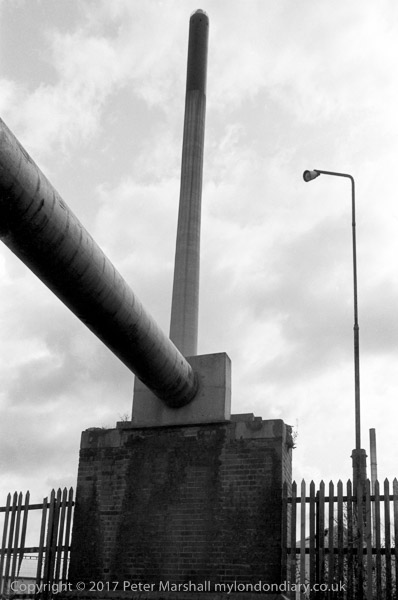
32r25: Pipe bridge, Bankside and Reckitt’s Chimney, Morland St, 1982 – River Hull
16 May 2017
The Hull and Barnsley Railway’s Hull Bridge was built in 1884-5 and is a steel bowstring swing bridge which was Grade II listed in 1994. The company, its full name the Hull Barnsley & West Riding Junction Railway and Dock Company (HB&WRJR&DCo) never quite managed to reach Barnsley, but in 1885 it opened a new dock, the Alexandra Dock, in East Hull. To reach there, the line had to go over the River Hull, and to preserve navigation rights it had to be a swing bridge. The square brick building at left (also listed) houses the operating cabin, though I think the bridge seldom opens and if required to do so uses an auxiliary winch on a break-down truck brought in for the occasion rather than the original machinery, which was hydraulic, but powered by steam.
The River Hull Bridge was a smaller version of one over the Ouse near Drax on the H&BR which was dismantled in 1976 but the Hull bridge remains in use.
The railway was mainly for goods, with goods station at Alexandra Docks, Burleigh St, Sculcoates, Dairycoates and Neptune St. There were passenger stations on the Beverley Rd and at Cannon St to the north of the city centre, and industrial branches to National Radiator and the British Gas Light Company at Bankside.
The railway became a part of its competitor around Hull, the North Eastern Railway in 1922, and then was merged into the London and North Eastern Railway (LNER) in 1923. The following year passenger services from Cannon St ended, with a link allowing trains to run into Paragon Station.
In 2007, work began to increase the capacity of the line over Hull Bridge to the King George Dock with some of the line which had been converted to single track going back to double and new signalling, and the line was re-opened in 2008. The section of line over the bridge is still only single track. Since then further work has been carried out, including galvanising 15 tonnes of structural steel for the bridge. There are no passenger services on the line but significant goods traffic.
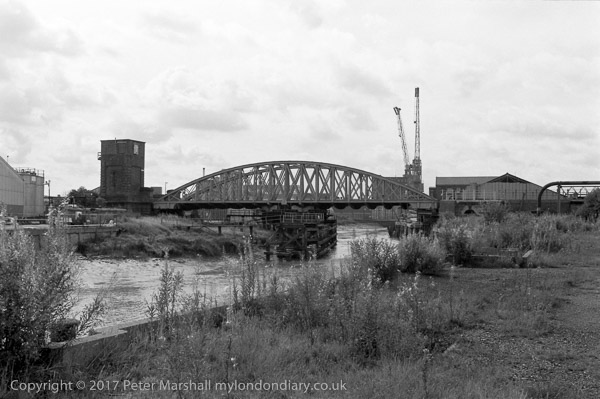
32r26: Hull swing railway bridge and River Hull from Bankside, 1982 – River Hull
17 May 2017
I think these two young boys were outside their house on Goddard Avenue, which certainly has some miniscule front gardens like these, though it could have been another street in the area. The display of toys was for sale and I think I may have bought a small lorry from their stock.
Roadside sales such as these were fairly common during the school holidays in Hull.
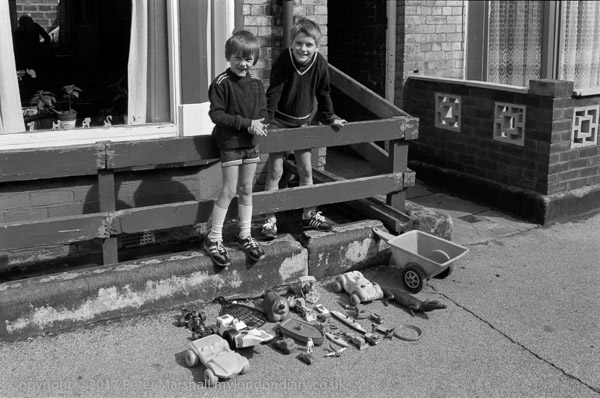
32r23: Pavement toy sale, Goddard Avenue area, 1982 – Springbank
You can see the new pictures added each day at Hull Photos, and I post them with the short comments above on Facebook.
Comments and corrections to captions are welcome here or on Facebook.
______________________________________________________
There are no adverts on this site and it receives no sponsorship, and I like to keep it that way. But it does take a considerable amount of my time and thought, and if you enjoy reading it, a small donation – perhaps the cost of a beer – would be appreciated.
My London Diary : Buildings of London : River Lea/Lee Valley : London’s Industrial Heritage
All photographs on this and my other sites, unless otherwise stated, are taken by and copyright of Peter Marshall, and are available for reproduction or can be bought as prints.